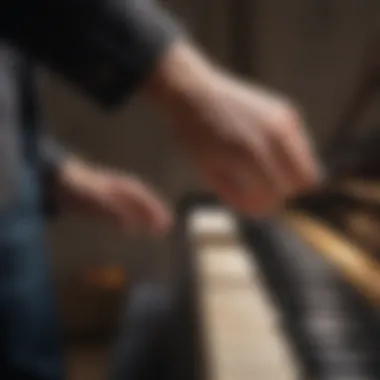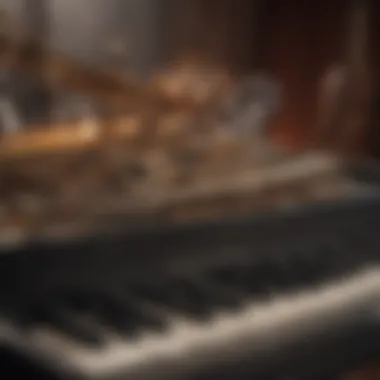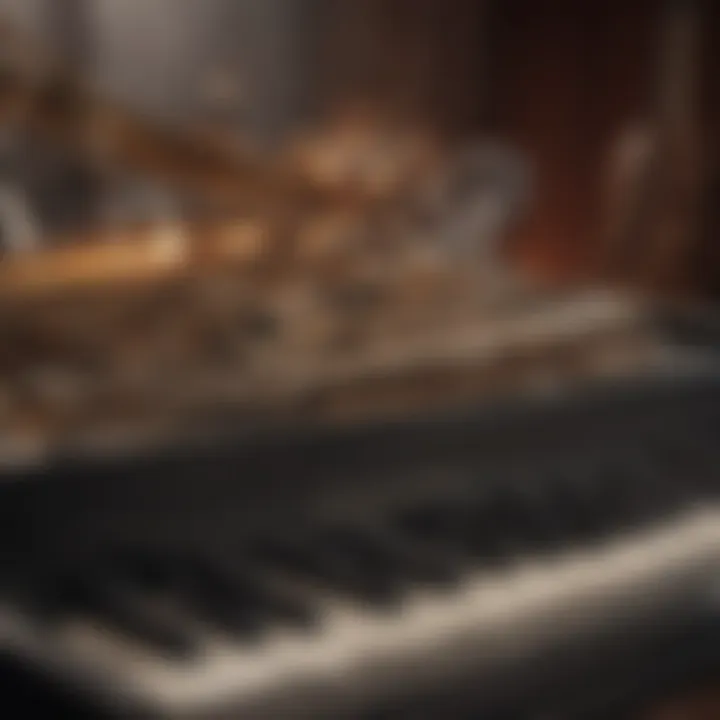Essential Jazz Piano Pieces for Aspiring Musicians


Intro
Jazz piano is a captivating and intricate genre that beckons aspiring musicians to explore its depths. The melodic and rhythmic complexities offer rich layering, making it essential for beginners to grasp foundational concepts. This article aims to present jazz piano pieces that are suitable for those just starting. As we delve into this journey, we focus on key compositions, practice strategies, and the importance of improvisation. Understanding these elements will enhance your playing and appreciation for jazz music.
Artist Profile
Jazz musicians often serve as the beating heart of the genre. Knowing prominent figures can provide insight into the styles and techniques. Here, we will highlight influential artists who shaped jazz piano.
Biography and Background
One cannot discuss jazz piano without mentioning the legendary Thelonious Monk. Born in 1917, Monk revolutionized jazz with his distinctive style. He combined unconventional harmonies with an extraordinary sense of rhythm. His contribution to the genre remains unparalleled.
Another iconic figure is Bill Evans. His unique approach to harmony and interaction with other musicians set him apart. Evans drew from classical influences, giving his jazz a fresh and refined touch.
Major Influences and Inspirations
The influences behind these artists shed light on their musical journey. Thelonious Monk was heavily inspired by gospel music and blues. This background shaped his improvisational style, allowing him to create expressive melodies.
Bill Evans cited Claude Debussy and George Gershwin as significant inspirations. Their rich harmonies and melodic lines helped Evans fuse classical and jazz elements seamlessly.
Song Analysis
Understanding notable compositions is vital for beginners. Analyzing these pieces can help improve technique and musicality.
Theme and Lyrics Breakdown
While jazz is largely instrumental, some pieces do have lyrics. For example, "Blue in Green" by Bill Evans offers emotional depth through its melancholic theme. This song invites pianists to explore the nuances of expressive playing.
Instrumentation and Composition
Jazz piano often collaborates with other instruments. "Round Midnight", another piece by Thelonious Monk, showcases piano, bass, and saxophone. The contrast between these instruments enriches the texture and invites exploration into ensemble playing.
Practice Strategies
Effective practice is fundamental for growth as a jazz pianist. Here are some strategies to enhance your skills:
- Consistent Practice: Regular sessions foster improvement.
- Listening: Immerse yourself in jazz recordings for inspiration.
- Improvise: Experiment with your own melodies and forms.
The End
As this exploration of jazz piano pieces for beginners unfolds, it becomes clear that understanding key elements and artists is crucial for growth. By engaging with the music of Monk, Evans, and others, aspiring musicians can develop a unique voice in the genre. Embrace the journey and continue to learn.
Prologue to Jazz Piano
Understanding jazz piano is crucial for anyone eager to delve into this vibrant musical world. The piano serves as one of the primary instruments in jazz, allowing musicians to express creativity and harness decades of musical evolution. Moreover, jazz piano embodies distinct styles, improvisation techniques, and a unique sense of rhythm that can greatly enhance one's overall musicianship.
Jazz piano offers a plethora of benefits for beginners. First, it helps to develop foundational skills such as chord progressions, harmonic knowledge, and rhythm. Second, it provides essential tools for improvisation, a core aspect of jazz. Improvisation not only develops a player's ability to express emotions musically but also deepens their understanding of music theory and arrangement.
Furthermore, embracing the genre can significantly enhance one's listening skills. Engaging with jazz music often leads to an appreciation of its rich history and diverse influences. As aspiring musicians explore different compositions, they gain insights into the essential elements that make up jazz, ensuring a richer learning experience in their musical journey.
Understanding Jazz as a Genre
Jazz is a dynamic genre with a deep cultural background. It originated in the early 20th century, primarily in New Orleans, and it reflects a fusion of African rhythms, blues, and European musical traditions. Over the years, jazz has evolved into various styles, including dixieland, swing, bebop, and modal jazz. Each of these styles showcases unique characteristics and approaches to improvisation.
One essential feature of jazz is its emphasis on personal expression. Unlike classical music, which often adheres strictly to written notation, jazz musicians often rely on personal interpretation. This improvisatory nature allows each performance to be distinct, reflecting the individual artist's feelings and experiences. In jazz, a musician is not just a player but a storyteller, conveying emotions through music.
Moreover, harmony in jazz is worth noting. Jazz chords can often be complex, incorporating extended intervals and alterations. This harmonic richness gives a depth to the music that appeals to many listeners. In essence, understanding jazz as a genre involves not just recognizing its historical roots but also appreciating the improvisational and harmonic elements that define it.
The Role of Piano in Jazz
The piano occupies a vital position in jazz music. It serves both as a rhythmic foundation and a melodic instrument, making it versatile for various styles of jazz. Pianists are responsible for shaping the harmonic structure of the piece while also providing counter-melodies that can create intricate dialogues with other instrumentalists.
Jazz piano techniques like voicing, comping, and soloing are fundamental. Voicing involves how a pianist structures chords, often adding tensions and extensions. Comping refers to the accompaniment style, where the pianist adds rhythmic and harmonic support to soloists. Soloing, on the other hand, showcases the pianist's skill in improvisation, allowing for spontaneous creativity during performances.
The influence of notable jazz pianists such as Thelonious Monk, Bill Evans, and Oscar Peterson cannot be overlooked. Their approaches have shaped modern jazz piano techniques and continue to inspire aspiring jazz musicians today. By learning from these masters, beginners can develop their unique voice while adhering to the fundamental principles of jazz piano playing.
Fundamental Concepts of Jazz Piano
Understanding the fundamental concepts of jazz piano is crucial for beginners. These concepts serve as the building blocks for more advanced techniques and improvisation. Recognizing how jazz piano pieces are constructed leads to a deeper comprehension of the genre itself. Moreover, grasping these essentials equips aspiring musicians with the necessary tools to explore and express their creativity.
Chord Structures and Harmony
Chord structures are at the heart of jazz music. In contrast to traditional western music, jazz often employs extended chords which incorporate more notes than the basic triads. For instance, seventh chords are fundamental in jazz, adding depth and richness to a composition. Moreover, jazz harmony frequently involves substitutions and alterations that create tension and resolution. This fluidity encourages improvisation, as pianists can navigate through different harmonic landscapes with ease.
Understanding harmony requires familiarity with chord progressions. The ii-V-I progression stands out as a quintessential jazz pattern. By practicing these structures, beginners lay a solid foundation for playing more complex pieces. Knowing how chords relate can significantly enhance a pianist's ability to improvise.
Additionally, it's important to explore common chord progressions like the Circle of Fifths. This progression is a series of chords moving in perfect fifths, providing a framework for many jazz standards. Practicing these elements can help beginners become adept at recognizing patterns in jazz pieces.
Rhythm and Swing Feel


Rhythm in jazz is unique, primarily characterized by its swing feel. Swing is not merely a time signature; it's a way of interpreting rhythm. In essence, it involves delaying the second eighth note in a pair, creating a laid-back groove. This rhythm sets jazz apart from classical forms. It is vital for beginners to practice this feel to play authentically.
Counting aloud while playing can help develop a sense of swing. Start slow and gradually increase the tempo. Drummers like Max Roach and bassists such as Ron Carter exemplify the essential role of rhythm in jazz. Listening to them can provide insights into how to internalize the swing feel.
Practicing with a metronome or backing track also aids in achieving a good sense of rhythm. This strategy allows beginners to keep time while experimenting with syncopation and off-beat accents, both of which are hallmark traits of jazz.
Jazz Scales and Modes
Jazz incorporates a variety of scales and modes that provide musicians with a way to navigate through improvisational settings. The major scale, minor scale, and pentatonic scales form the backbone of improvisation. Furthermore, modes such as Dorian, Mixolydian, and Aeolian offer distinct flavors for soloing over different chord types.
For instance, the Dorian mode brings a jazzy feel over minor chords, while the Mixolydian mode works well for dominant chords. By practicing scales in various keys, beginners can build finger strength and flexibility. Employing the circle of fourths or fifths can assist in learning jazz scales more effectively.
Ultimately, developing a strong understanding of scales equips beginner pianists with the skills to express their musical ideas freely. Improvisation is undeniably an essential part of jazz, and a solid grasp of scales and modes illuminates the path toward creativity in performance.
"Jazz is not just music, it's a form of life. To master it, one must first understand its language."
By dedicating time to these fundamental concepts, beginners lay a foundation that will serve them well throughout their jazz piano journey.
Essential Techniques for Beginners
The realm of jazz piano is rich and complex. It requires more than just familiarity with notes or scales. Essential techniques form the bedrock for any aspiring jazz pianist. Mastering these techniques paves the way for deeper exploration into more sophisticated concepts. Understanding the fundamental skills is crucial for effective practice and facilitates growth in musical expression.
Basic Finger Placement
Proper finger placement is paramount for beginner pianists. It ensures that one can play with both agility and comfort. Start with the foundation of positioning. Place your fingers naturally across the keys. The thumb should rest on C, while the other fingers align with adjacent white keys.
This positioning allows for:
- Ease of movement: Moving across keys becomes fluid.
- Reducing tension: Proper placement lessens strain on your hand.
- Improved speed and accuracy: You can play faster with fewer errors.
Focus on finger strength through practice. Spend time on simple scales. Exercise your fingers through arpeggios and five-finger patterns. Rhythm and style emerge with proficiency in finger usage, shaping the overall sound.
Simple Rhythmic Patterns
Rhythm is the heartbeat of jazz. It adds character to music and sets the pace. Begin with simple two and four beats patterns. Use a metronome to develop a steady beat. This helps discipline timing and introduces swing feel, an essential component of jazz.
Explore these rhythmic patterns:
- Quarter notes: Basics of rhythm; they help maintain steady tempo.
- Eighth notes: Creates a drive in your playing.
- Swing feel: Learn to add syncopation, making rhythmic playfulness.
Incorporating these patterns into your practice routines builds a strong rhythmic foundation. Experiment with variations once comfortable. This exploration brings personality and nuance to performance.
Prelims to Improvisation
Improvisation distinguishes jazz from other music genres. It allows players to express their individuality and creativity in real-time. For beginners, the idea of improvisation can be daunting. Starting simple eases one into the process.
Begin improvisation with:
- Familiarity with scale patterns: Knowledge of basic scales is essential. Focus on major and minor scales. This will facilitate improvisation over chord changes.
- Listening and play-along: Engage with recordings of established jazz musicians. Playing along can spark ideas on how to approach improvisation.
- Use of motifs and phrases: Create short, repeating phrases. Then develop them, adding variations as you go along.
Emphasizing improvisation opens avenues for personal expression in jazz. Each player brings their unique voice, enriching the genre. Celebrate mistakes as learning experiences on this creative journey.
Notable Jazz Piano Pieces for Beginners
Understanding notable jazz piano pieces serves several purposes for those starting their journey in jazz music. Firstly, it exposes beginners to fundamental melodies, rhythms, and harmonies that are essential for their growth. Novice musicians can harness these pieces to develop their practical skills while engaging with essential concepts from jazz history. Secondly, these compositions often embody various styles within jazz, providing a well-rounded approach to learning. By familiarizing themselves with these significant works, beginners lay a foundation that enhances their improvisational skills and overall musicianship.
Autumn Leaves by Joseph Kosma
Autumn Leaves, composed by Joseph Kosma, is a classic piece often recommended for beginners. Its simple yet captivating chord progressions and memorable melody are approachable. The tune follows a common 32-bar form and introduces students to ii-V-I progressions, critical in jazz.
Practicing Autumn Leaves helps with harmonic understanding as pianists learn how to navigate changes effectively. Additionally, this piece is versatile. Musicians can personalize it through various interpretations, including swing feel or different tempo choices. Because of its popularity, there are many recorded versions, making it easier for students to hear how different artists interpret the same melody.
Blue Monk by Thelonious Monk
Blue Monk, written by Thelonious Monk, is a twelve-bar blues that offers a unique opportunity to engage with jazz improvisation. Its catchy bass line and straightforward structure make it an excellent choice for those embarking on their jazz journey. The blues scale featured in this piece is fundamental to many jazz styles, emphasizing the cultural roots of this genre.
Beginning pianists can focus on two areas here: playing the melody smoothly and inventing simple solos over the chord changes. This enhances their skills in improvisation. The rhythmic feel of Blue Monk allows beginners to experiment with their swing and timing, which is a crucial aspect of jazz performance.
Cantaloupe Island by Herbie Hancock
Cantaloupe Island, composed by Herbie Hancock, is known for its infectious groove and laid-back vibe. This piece blends elements of jazz and funk, making it appealing for beginners seeking rhythm. Its simple form and repetitive nature help students focus on developing their timing and swing feel without becoming overwhelmed by complexity.
Learning to play Cantaloupe Island encourages creative expression, as it invites improvisation. Pianists can explore various scales while playing, providing a canvas for personal expression. Subsequently, this piece teaches how slight variations in rhythm and dynamics can dramatically affect the overall feel of a performance.
Freddie Freeloader by Miles Davis
Freddie Freeloader is another essential work, originating from Miles Davis' legendary album Kind of Blue. This piece is structured around a straightforward blues form, making it accessible for beginners. The rich harmonies and soft dissonances introduce pianists to modal jazz without being overly complex.
Playing Freddie Freeloader can sharpen a student’s ability to listen and react, as the piece encourages interaction with other musicians. It allows for collaborative learning, making it a suitable choice for practice sessions with fellow musicians. As beginners become more familiar with this piece, they can experiment with improvisation and rhythmic variation, reinforcing their jazz repertoire.


The importance of learning these iconic pieces cannot be underestimated, as they serve as gateways to deeper musical understanding and stylistic exploration.
In summary, these notable jazz piano pieces are integral for beginners. They provide a variety of styles, techniques, and improvisational opportunities essential for growth in jazz piano. Engaging with these works not only enhances basic skills but also cultivates a deeper appreciation for the genre as students progress.
Practice Strategies for Jazz Piano
Effective practice strategies are crucial for musicians at any level, but particularly for beginners in jazz piano. In the intricate and often improvisational world of jazz, having a structured approach to practice can greatly enhance one's understanding and skills. Setting goals, integrating listening habits, and utilizing technology, such as backing tracks, can contribute to a more enriched learning experience.
Setting Realistic Goals
Establishing clear goals is essential. Instead of vague intentions, like "I want to be better at jazz piano", specify achievable objectives. For instance, focus on mastering "Autumn Leaves" within two months. This creates measurable progress and keeps motivation high. Consider breaking down your goals into smaller, manageable tasks.
- Short-Term Goals: These might include learning a specific piece or technique by the end of the week or practicing for a set period each day.
- Long-Term Goals: These may encompass mastering a particular style or preparing for a performance.
Realistic goals prevent frustration and help maintain interest. They provide a roadmap, allowing you to track improvements over time.
Integrating Listening into Practice
Listening is an often-overlooked aspect of practicing jazz piano. Actively listening to recordings can reveal nuances in style and performance. Spend time analyzing various artists to understand their interpretation of jazz. This practice not only enhances your aural skills but also deepens your appreciation for jazz as an art form.
- Active Listening: Engage with recordings by trying to replicate what you hear. This could be transcribing solos or imitating articulation styles.
- Diverse Sources: Explore different jazz pianists such as Bill Evans, Oscar Peterson, or more contemporary players. This variety can inspire unique interpretations in your own playing.
Combining practice with listening creates a more cohesive understanding of jazz piano.
Utilizing Backing Tracks
Backing tracks are an invaluable resource for budding jazz pianists. They provide the rhythmic and harmonic context needed for practice and improvisation. Using tracks allows you to simulate playing within a band and helps develop timing and phrasing.
- Online Resources: Websites like YouTube and specialized jazz platforms offer a broad selection of high-quality backing tracks. Look for tracks identified as "slow" versions to ease into complex pieces.
- Improvisation Practice: Playing along with backing tracks encourages improvisation. Challenge yourself to incorporate new chord progressions or melody ideas into your play.
Utilizing backing tracks enables you to enjoy the collaborative spirit of jazz, even when practicing alone.
Important Note: Having a structured practice routine where you focus on setting goals, integrating listening, and utilizing technology provides a solid foundation for becoming a proficient jazz pianist.
The Importance of Listening in Jazz Piano
In the journey of learning jazz piano, the act of listening plays a crucial role. It goes beyond simply hearing melodies; it encompasses understanding nuances, phrasing, and the unique language of jazz. Listening actively cultivates a deeper appreciation of the genre and enhances one's musicianship.
When beginners spend time immersing themselves in jazz, they start to internalize the rhythms, styles, and expressions that define the music. This exposure helps them develop a sense of timing and improves their ability to play along with other musicians. Effective listening can also guide them in making informed choices regarding their own improvisation and compositions.
Key elements of listening include:
- Recognizing Jazz Standards: Familiarizing oneself with well-established jazz pieces offers a framework for understanding common structures and innovations in the music.
- Analyzing Styles and Techniques: Attentive listening encourages aspiring jazz pianists to identify and replicate techniques used by seasoned players.
- Enhancing Creativity: Listening nurtures creativity by exposing individuals to a range of improvisational styles and ideas.
Listening actively fosters a connection to the music which is vital in jazz. It provides insights into the art form that cannot be replicated just through practice alone.
Familiarizing with Jazz Standards
Jazz standards are the backbone of the jazz repertoire. Knowing these pieces is essential for any aspiring jazz pianist. Familiarity with such pieces will help musicians navigate performances with confidence and ease. Standards often feature common chord progressions and structures, making them accessible for practice and performance. They serve as a blueprint for improvisation as well.
Examples of essential jazz standards include:
- Autumn Leaves: A staple in jazz education that presents a beautiful melody along with its harmonic challenges.
- Blue Monk: This composition showcases a bluesy feel which is fundamental to many jazz styles.
- My Funny Valentine: Rich with emotional depth, it offers various approaches for expression and improvisation.
By learning these pieces, beginners build a solid foundation. They develop the ability to transition between melodies while understanding their harmonic context.
Studying Influential Jazz Pianists
Studying the works of influential jazz pianists provides valuable insights into various styles and approaches to jazz performance. Each pianist brings a unique perspective and set of skills that can inspire and enrich a beginner's learning experience.
Notable jazz pianists worth exploring include:
- Bill Evans: His harmonic innovations and lyrical style are significant in modern jazz piano. Listening to his recordings reveals complexities in his melodic choices.
- Thelonious Monk: Known for his distinctive approach, Monk's use of dissonance and rhythm challenges traditional notions of melody and harmony.
- Oscar Peterson: His technical prowess combined with an extensive repertoire allows for a deep dive into swing and rhythmic phrasing.
Incorporating the styles of these pianists can help beginners recognize the nuances of jazz and how to express themselves through their instrument. Learning their works and techniques enhances both listening skills and performance abilities, making it a critical part of jazz education.
Listening in jazz piano is not just about replicating sounds; it’s about understanding the music's essence and developing one's own voice within it. Engaging in this practice can lead to a more enriching musical journey.
Building a Jazz Piano Repertoire
Building a jazz piano repertoire is a crucial step for beginners aspiring to become proficient in this versatile genre. A well-rounded repertoire serves as a musical library from which you draw upon as a musician. It enhances both your performance skills and encourages improvisation, an essential element in jazz. Learning diverse pieces not only improves your technical skills but also deepens your understanding of jazz techniques and styles.
Choosing Suitable Pieces
When starting, it is important to choose pieces that are appropriate for your skill level. Selecting works that are too challenging can lead to frustration, while those that are too simple might not present enough of a learning opportunity. Consider starting with well-known jazz standards that have simpler chord progressions and melodies. Here are a few recommendations:
- "Autumn Leaves" by Joseph Kosma
- "Blue Monk" by Thelonious Monk
- "Cantaloupe Island" by Herbie Hancock
These pieces are foundational in jazz and present essential elements like chord changes and rhythmic patterns. Make sure to consider not only the technical challenges of each piece but also your personal musical interests. Playing pieces that excite you will foster a deeper connection with the music.


Learning to Play by Ear
Developing the ability to play by ear is an instrumental skill in jazz. This technique allows musicians to understand melodies and harmonies intuitively, rather than relying solely on sheet music. To cultivate this skill, start with simple tunes. Listen to a piece repeatedly, and then try to replicate it on the piano. Focus on identifying the melody first, then move on to the chords.
Regular practice can significantly enhance your aural skills. As you become comfortable with simpler pieces, challenge yourself with more complex melodies and harmonies. Additionally, consider using apps or websites that provide ear training exercises. The ability to play by ear will not only improve your repertoire but also enhance your improvisational skills.
"The most important thing is to listen closely; you can play any piece well when you are attuned to the music."
Exploring Different Jazz Styles
Understanding various jazz styles is essential for beginners diving into jazz piano. Each style possesses unique characteristics that shape playing techniques and improvisational skills. Knowing these styles aids in recognizing the context of certain pieces, enhancing both performance and listening experiences. Moreover, exploring different jazz styles opens avenues for creative expression, inviting musicians to draw inspiration from iconic composers and players.
Straight-Ahead Jazz
Straight-ahead jazz is often seen as the fundamental style of jazz, characterized by its centered structure and adherence to traditional jazz forms. This style emphasizes swing rhythms and a strong sense of melody, serving as a bridge between jazz and popular music.
For beginners, straight-ahead jazz pieces often provide a solid foundation. Notable compositions such as "Take the 'A' Train" by Duke Ellington or "So What" by Miles Davis can be excellent starting points for developing rhythmic precision and chordal knowledge.
Playing in this style encourages musicians to focus on:
- Swing Feel: Achieving a steady groove enhances the overall performance.
- Melodic Improvisation: Learning to improvise while maintaining the melody is a crucial skill.
- Chord Progressions: Familiarity with common progressions supports harmonic exploration.
Modal Jazz
Modal jazz marks a departure from the traditional chord-based progression in favor of scales or modes. This style is notable for its focus on improvisation, allowing musicians greater freedom to explore. "So What" by Miles Davis is an example where modal principles are used effectively.
For beginners, modal jazz introduces a new way of thinking about harmony and improvisation:
- Understanding Modes: Each mode offers different emotional colors and mood.
- Linear Improvisation: Musicians can develop solos based on scale patterns rather than chord changes.
- Listening to Modal Compositions: Studying pieces by composers such as John Coltrane helps in grasping the nuances of this style.
Bebop and Beyond
Bebop represents a significant evolution in jazz history, emphasizing complex melodies and intricate harmonies. This style arose in the 1940s and often features fast tempos and sophisticated chord progressions. Classic bebop pieces include "A Night in Tunisia" by Dizzy Gillespie and "Ornithology" by Charlie Parker.
For beginners, engaging with bebop can be both challenging and rewarding:
- Dissonance and Resolution: Understanding how tension and release work within the music elevates a performance.
- Speed and Technique: Practicing fast lines develops agility and coordination on the piano.
- Improvisational Language: Learning the bebop language helps aspiring musicians establish their voice in jazz.
"Knowing the different styles of jazz enriches your playing. It lets you express yourself in many unique ways."
Community and Collaboration in Jazz
The realm of jazz piano is not just about mastering individual skills or pieces; it is equally about the connections forged within the musical community. Community and collaboration in jazz play a critical role in the growth of musicians. This genre has a rich history of collective improvisation, where individual voices come together to create something larger than themselves. By engaging with fellow musicians, beginners can experience the dynamic interaction that defines jazz.
Joining Music Groups and Clubs
Participating in music groups and clubs offers numerous benefits for aspiring jazz pianists. These settings provide a space to share knowledge, techniques, and experiences. Musicians can learn from one another, gaining insights that may not be accessible through solo practice.
Some advantages of joining music groups include:
- Networking Opportunities: Meeting other musicians can lead to collaborations, performances, and friendships.
- Motivation: Being part of a group encourages regular practice and commitment.
- Feedback: Members can offer constructive criticism, helping each other improve.
Many cities have local jazz clubs that host jam sessions. Attending these events can nurture skills through real-time collaboration. Beginners can gain confidence by playing alongside more experienced musicians and learn the nuances of timing and improvisation.
Attending Workshops and Masterclasses
Workshops and masterclasses are invaluable resources for beginners looking to deepen their understanding of jazz piano. These events allow participants to gain knowledge from seasoned professionals. Typically, these sessions cover a variety of topics, from technique to specific jazz styles.
Key benefits of attending such events include:
- Hands-on Learning: Participants can practice with guidance from experts.
- Exposure to Different Styles: Each instructor brings their unique perspective, helping musicians discover new approaches.
- Q&A Sessions: Attendees can ask questions directly, fostering a deeper understanding of complex topics.
Overall, collaborative environments—whether through clubs or formal workshops—are essential to a musician’s journey in jazz piano. They reinforce the idea that while personal practice is crucial, sharing experiences and working together ultimately enriches one’s musical capability. As jazz is inherently collaborative, engaging with the community will enhance both skill and enjoyment in playing.
Ending
In summary, the exploration of jazz piano pieces offers a gateway for beginners into the vast world of jazz music. This article highlights several core elements that enhance both technical skills and musical understanding. Firstly, recognizing notable jazz pieces like Autumn Leaves and Blue Monk allows beginners to connect with the genre’s rich history. These iconic works are not just melodies; they represent the artistic journey of esteemed composers and musicians.
Additionally, the analysis of essential techniques prepares aspiring pianists for effective practice strategies. Simple rhythm patterns, a firm grasp on chord structures, and improvisational approaches work together to create a solid foundation. Emphasizing these techniques leads to improved proficiency and a deeper appreciation for the nuances of jazz.
An often-overlooked aspect is the importance of community in jazz. Engaging with fellow musicians and attending workshops nurtures growth and encourages collaboration. Ultimately, these elements don't just enhance the learning experience; they transform it.
"Listening to jazz should not just be an experience, but a lens through which you can understand and explore your own musical journey."
Recap of Key Takeaways
To succinctly outline the discussion:
- Understanding genre: Familiarity with jazz as a dynamic musical form is crucial.
- Key Pieces: Notable compositions serve as both inspiration and learning tools.
- Techniques: Fundamental skills like improvisation and rhythm are necessary for building proficiency.
- Practice Strategies: Incorporating realistic goals and community engagement enhances learning and motivation.
Encouragement for Continued Practice
Continued practice is the cornerstone of mastering jazz piano. As beginners progress, it is vital to maintain an active and structured practice schedule. Framing goals ensures steady improvement.
Exploring different pieces will not only enhance repertoire but also expose players to varying styles and improvisational techniques. Investing time in both solo practice and group play provides rich learning experiences.
Embrace challenges along the way. Remember, every pianist has faced difficulties; persistence is key. With passion and commitment, the journey through jazz piano can be incredibly rewarding, both personally and musically.







